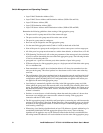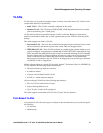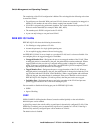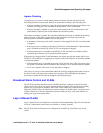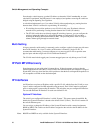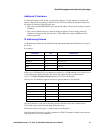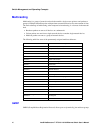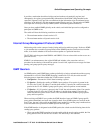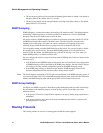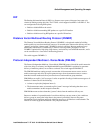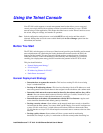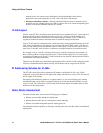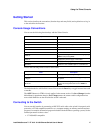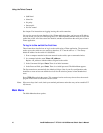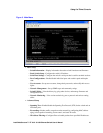42 Intel® NetStructure™ ZT 8101 10/100 Ethernet Switch User’s Manual
Switch Management and Operating Concepts
• The second query packet will be sent after the Startup Querier Interval, which is one fourth of
the Query Interval. By default, this is 31 seconds.
• The next query packets will be sent periodically according to the Query Interval. The default
Query Interval is 125 seconds.
IGMP Snooping
IGMP Snooping is a feature that reduces the flooding of IP multicast traffic. The default behavior
for handling a multicast packet is to flood the packet to all members of a VLAN. With IGMP
Snooping, only the active member ports receive the data.
All groups learned by IGMP Snooping are recorded in an internal group table with the VLAN ID
and Multicast Group Address used as the table's index. The table's port list stores the active
member ports for this group. This table can contain a maximum of 128 groups. If the active
multicast groups exceed this limit, the new group's data will be flooded in the VLAN.
You can globally enable or disable IGMP Snooping on the switch. You can also enable or disable
the snooping for a specific VLAN. You must enable IGMP globally for it to be enabled on a
specific VLAN. By default, the IGMP global flag is off and VLAN flag is on. Thus, when you
enable IGMP globally, it is enabled on all VLANs.
You can configure the switch to snoop and to keep track of IGMP groups. These two interact in the
following ways:
• If the IP interface has IGMP Snooping configured for the associated VLAN, the configuration
of IGMP Snooping will be overwritten by the IGMP group settings. On such VLANs, the per-
VLAN flag is the only available configurable option on the IGMP Snooping screen.
• If the IGMP group settings are disabled on the interface, IGMP Snooping on the VLAN
becomes configurable and the switch uses these settings for the VLAN.
Note: The switch supports a maximum of 255 VLANs and a maximum of 128 IGMP Snooping groups. If
you create more than 128 VLANs with IGMP Snooping enabled, some of those VLANs will not be
added to the IGMP Snooping table and the group's data will be flooded in the VLAN.
IGMP Group Settings
An IP host uses IGMP to register its IP multicast group membership with the switch. Periodically,
the switch queries the multicast group to see if the group is still in use and takes one of the
following actions:
• If the group is still active, a single IP host responds to the query, and the group registration is
maintained.
• If the group is inactive and a report is not received within the time limit for a response, the
group registration is removed.
Routing Protocols
This section presents an overview of routing protocols that the switch supports.



